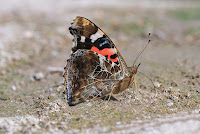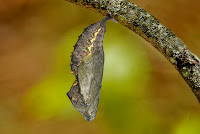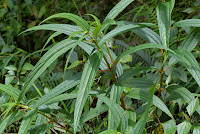<> Vanessa indica (Herbst, 1794) <>
the Indian Red Admiral ผีเสื้อแดงอินเดีย
Click on any photo to see all photos full size in Lightbox
Additions and corrections to the information provided on this page is always welcome. Please use the Contact form.

Photo taken near Kalaw, Taunggyi District, Myanmar. ~1400m a.s.l.

An uncommon species in SW Asia and is only found across the northern part of the region. The sexes are almost identical in appearance and it is not possible to determine the sex in the field. It is a strong flier with rapid wingbeats and the males are very territorial, defending their patch very aggressively. They bask on low vegetation or rocks with their wings spread flat. Males are often seen puddling on mud or other sources of nutrients. When disturbed this species will often fly up and perch on tree trunks with head pointing downwards and with wings closed. When in this position they are very difficult to see due to the cryptic nature of the markings on the underside of their wings.
Vanessa indica is generally considered to be multivoltine with several broods per annum but is probably only univoltine or bivoltine at the higher altitudes. The female usually lays her eggs singly on the upperside of leaves but will sometimes lay them elsewhere on the host plant. Further research is needed on the life history of this species. Both sexes visit flowers for nectar.
Synonyms and previously used names: Pyrameis indica, Pyrameis asakurae, Pyrameis buana, Pyrameis callirhoe, Pyrameis horishanus, Pyrameis occidentalis, Vanessa horishana, Cynthia stephania, Papilio indica
Taxonomy: Animalia - Arthropoda - Insecta - Lepidoptera - Nymphalidae - Nymphalinae - Vanessa - indica
Regional subspecies: V.indica indica (NE India, Myanmar, N.Thailand, Laos, N.Vietnam, S.China, Taiwan, Philippines)
Regional Distribution: India, Nepal, Bhutan, Myanmar, Thailand, Laos, Vietnam, China, Taiwan, Philippines
 |
Tad Thong Waterfall area, Luang Prabang, Laos ~600m a.s.l. |
Habitat: Vanessa indica is mainly found in open areas near streams in montane forest at moderate to high elevations. It also occurs in grassland, urban gardens, parks and along the banks of rivers and streams. It has been recorded at elevations up to 3900m a.s.l.
Flight time: most of the year, depending on location Wingspan: 55-65mm
Life History: not fully known but may be similar to its close relative further west, V.atalanta, which is around 30 days from egg to adult.
Larval Hosts: Boehmeria clidemioides, Boehmeria densiflora, Boehmeria depauperata, Boehmeria japonica, Boehmeria nivea, Boehmeria penduliflora, Debregeasia orientalis, Girardinia diversifolia, Maoutia setosa, Nanocnide japonica, Oreocnide frutescens, Pipturus asper, Urtica cannabina, Urtica dioica, Urtica taiwaniana, Urtica thunbergiana (Urticaceae), Alcea rosea, Corchorus capsularis (Malvaceae), Ulmus parvifolia, Zelkova serrata (Ulmaceae), Broussonetia papyrifera (Moraceae), Humulus scandens (Cannabaceae). Hosts used depends upon location and availability of plant species.
Adult Food Sources: Nectar - Phanera championii (Fabaceae), Acer campbellii (Sapindaceae), Cyananthus incanus (Campanulaceae), Gentiana capitata (Gentianaceae), Magnolia campbellii (Magnoliaceae), Osbeckia stellata (Melastomataceae), Jasminum dispermum (Oleaceae), Wendlandia coriacea (Rubiaceae), Prunus cerasoides (Rosaceae), Bidens alba, Eupatorium japonicum, Gymnocoronis spilanthoides (Asteraceae), Lantana camara (Verbenaceae), Heliotropium arboreum (Boraginaceae). Other - mud puddling, rotting fruit, animal dung, tree sap.
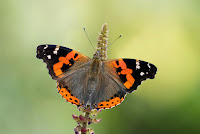 |
| Kalaw, Taunggyi District, Myanmar |
 |
| Gymnocoronis spilanthoides, a nectar source |
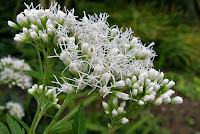 |
| Eupatorium japonicum, another nectar source |
Links to other pages in this series for species in the same subfamily
Junonia lemonias
Symbrenthia hypatia
Vanessa indica

